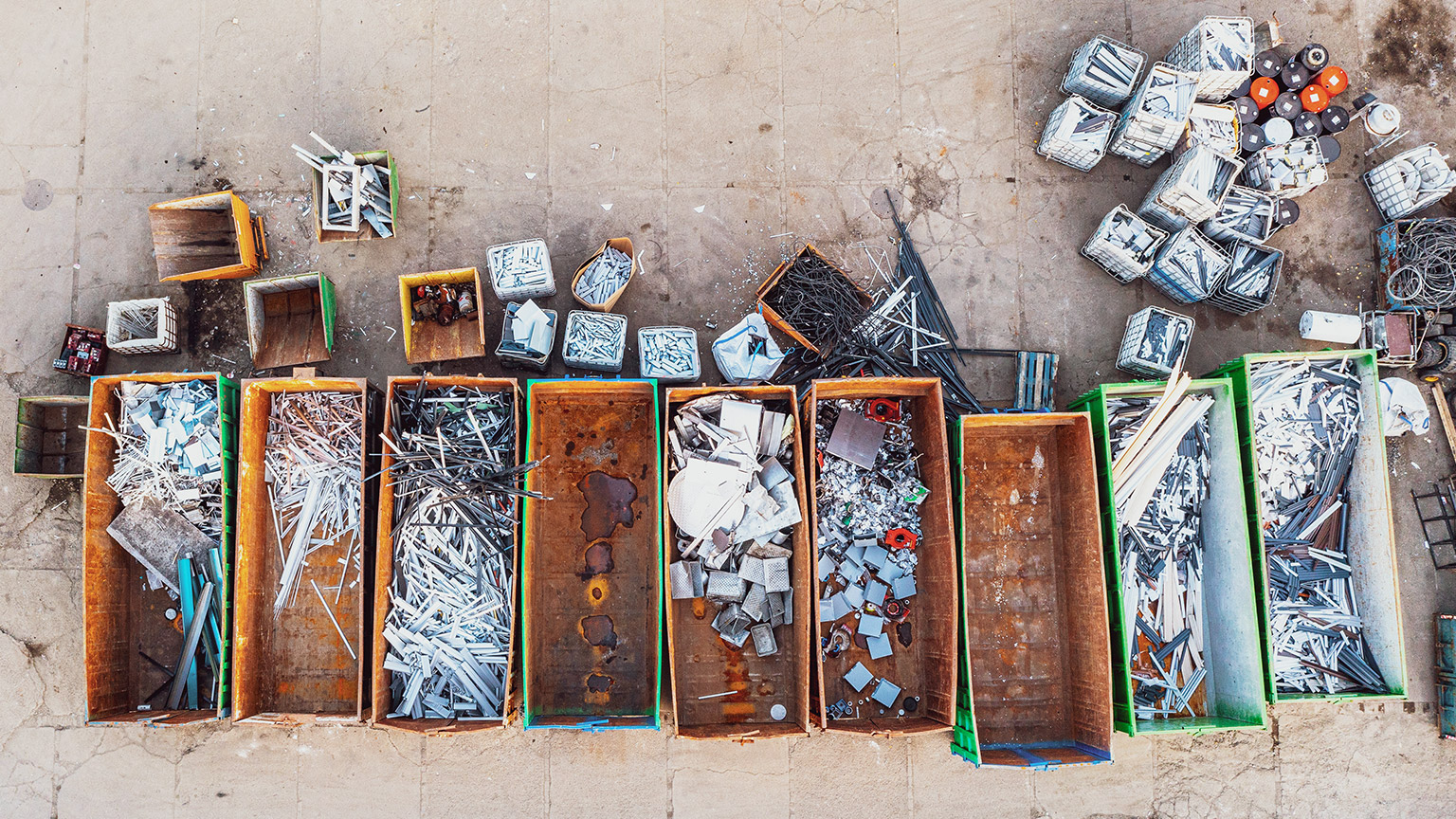We've now learned about the environmental problems we face and some of the solutions available — one of which is to manage the resources we use in the construction industry better than we have historically.
In this topic, we will cover the skills and knowledge required to plan a waste management strategy for your building project, which should include:
- identifying the current government and council environmental requirements for managing and minimising building waste
- environmental guidelines and standards associated with waste management strategies to support the building project
- costs, potential savings, and advantages of a waste management strategy
- effective communication with relevant professionals ensures project plans incorporate waste minimisation strategies.
Planning a waste management strategy
As a construction student, you must fully understand and familiarise yourself with requirements and standards as you start to undertake building projects. Non-compliance can lead to severe consequences ranging from hefty fines, penalties, legal actions, poorly constructed structures and buildings, property damage, work-related injuries, and even death of workers and civilians.
As a future construction manager, you will develop and review these environmental requirements and standards from a practical perspective so let's look at how they are applied to building projects in the next section.
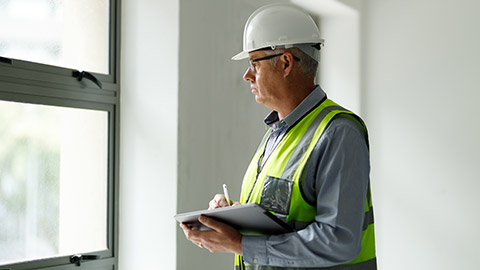
Developing waste management strategies for compliance with environmental regulations and guidelines is essential for sustainable waste management.
Be sure you know the following generic building and construction methods and principles. This information will enhance your understanding of how waste management strategies can be incorporated into your worksite practices.
Here is an activity that provides a general look at the five standard construction methods.

This stockyard sells reusable building materials from old houses and buildings.
The building method used for each project will impact the waste management strategy. For example, one construction method may create more waste products than another, or its type of waste may be harder to recycle.
When planning the waste management strategy, those in charge of creating it should consider minimising adverse environmental impacts and promoting sustainability.
When planning the reduction and removal of waste from the construction site in conjunction with the method of construction used, you'll need to consider:
- effective, efficient and economical procurement of materials and products
- assessment of the whole of the life cycle of materials and products
- engaging with environmentally responsible suppliers
- managing resource demand and consumption
- managing environmental risk
- recycling, reclaiming and reusing materials
- implementing on-site litter abatement
- reducing packaging waste.
Now that you have a clearer understanding of the generic construction methods, familiarise yourself with five general building and construction principles.
Below are examples of how these five principles can impact a project:
The following three of these five principles are relevant to the waste management strategy:
- Environmental protection: Environmental protection is often included in legislation, regulations and codes of practice. When considering the waste management plan, look to reduce the environmental impacts derived from building and development. Many of these legislative regulations have been explored in previous sections.
- Safety: How you manage waste reduction and removal must incorporate safety measures. Particularly, when looking at building methods that involve demolition and excavation using heavy machinery and are deemed to be higher risk, all personnel involved in the project should be working in a safe environment. Work Health and Safety legislation often regulates the safety of buildings and construction; therefore, accessing and implementing all aspects of the worksite is vital.
- Economy: The economy of construction work must incorporate recycling, reusing, and reducing waste as defined by the three R’s of the building project. Many of the measures the waste management plan incorporates can reduce the project's final costs, which is a benefit to the company and the environment that should not be taken lightly.
Waste Hierarchy
The Organization for Economic Co-operation and Development’ (OECD)In Aotearoa New Zealand in 2021, an average of 700 kilograms of waste per person was sent to landfill. That makes us one of the highest generators of waste per person in the ‘The Organization for Economic Co-operation and Development’ (OECD)
With figures like this in New Zealand as a population, we must reduce our consumption and avoid generating waste wherever possible, in line with the proposed waste hierarchy.
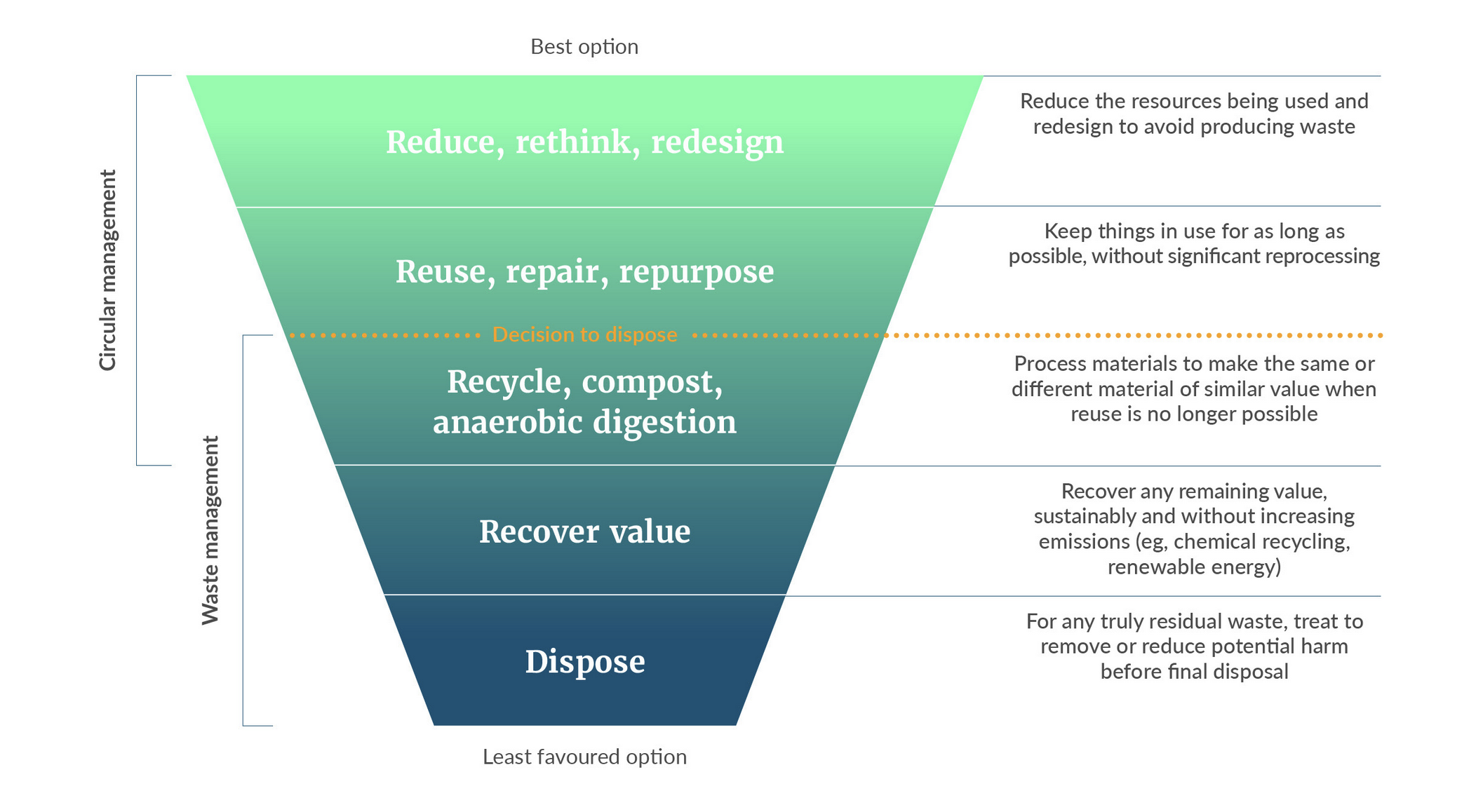
Therefore, after understanding basic building methods and principles, familiarise yourself with what the government has set out with their principles of sustainable waste management to add to your general construction knowledge.
These guiding principles are from the Aotearoa New Zealand Waste Strategy (2024):
- Take responsibility for how we make, use, manage and dispose of things.
- Protect and regenerate the natural environment and its systems.
- Ensure our systems for using, managing and disposing of materials are financially sustainable.
- Apply the waste hierarchy preferences to how we manage materials.
- Deliver equitable and inclusive outcomes.
- Think across systems, places and generations.
Further Reading
A more detailed look at these principles can be found on pages 18-19 of the Te-rautaki waste strategy.Here is an example of how each of these waste management principles could be implemented into a project.
| Avoiding waste | Purchase materials in measured bulk amounts and avoid individual packaging. |
|---|---|
| Improving Resource Recovery | Pulling water from wastewater, filtering, and putting it back into the system as clean, useable liquid |
| Increasing use of recycled material | Use recycled timber doors, and window frames on the residential build. |
| Managing material flows | Reduce the incidence of transporting materials by building on-site when possible. |
| Providing information to enable informed consumer decisions | Demonstrate and communicate the environmental and economic advantages of recycled, reclaimed or reused materials to clients when selecting materials for the building project. |
When planning to reduce and remove waste from the site in conjunction with the principles and methods discussed, be sure to select strategies for each project that complement each other to support the environmental requirements for managing and minimising building waste.
Consequences of poor waste practices
The effects of construction activity on waste production are enormous.
Level.orgConstruction and demolition waste makes up 40–50% of New Zealand’s total waste going to landfills, according to government and council documents. Each home constructed generates an average of four and a half tonnes of waste.
Much of this waste is potentially hazardous, and getting rid of it should be carefully planned. However, whatever the nature and characteristics of the waste, it all has one thing in common — it represents a loss of resources and money and reduces sustainability. In particular, traditional waste disposal, such as landfills and incineration, can cause serious local environmental damage.
Managing environmental risk
Although reducing waste is the highest priority for the waste management plan, proper disposal ensures that harmful waste does not leak into the environment. In some instances where the creation of waste by-products is unavoidable, these measures are even more necessary.
For the construction site, some risk management techniques to reduce waste may include:
- implementing sustainability features specified in the design, reducing environmental impacts from building
- source and make use of recycled or reused materials
- access environmentally certified materials and order with ample lead time
- separate waste flows on-site
- instruct and charge subcontractors who fail to use preferred environmental practices
- ensure that liquids, solvents and finishes are air-quality friendly for indoors
- conserve on-site biodiversity.
Litter abatement on-site
Source: Safety Buyer
Litter on any construction site project can come from the building process itself and the people working on the site.
We know you know what litter is, but do you really know what litter is and what harm it causes? Use this activity to refresh your understanding.
When faced with the clear hazard that litter poses, you can see why your waste management strategy must incorporate appropriate “litter abatement” procedures. When you add on-site litter abatement practices to your current waste management strategy, first identify the practices you can implement on-site to reduce the amount of litter generated.
For example:
| Litter abatement practice | Explanation of how this minimises litter |
|---|---|
| Using trash bins with covers | The covers prevent the litter from falling out of the trash bin and scattering into the surroundings. |
| Having appropriate amounts of bins for recycling, chemical, green and general waste. | This decreases the likelihood of waste not being separated appropriately into the specified groups. |
There are two more areas on-site that you should focus on when addressing project litter, namely:
- Waste processing logistics
- Subcontractor responsibilities
Waste processing logistics
As we have stated, building design and site management should aim to minimise waste, which reduces the need for waste disposal and the release of pollutants. The impact of the project's disposal of materials at the end of their serviceable life must be considered at the planning and design stage.
If materials on the construction site can be recycled, this will reduce the need for new materials to be brought and produced. Just think about it — the energy required to reconstitute materials is generally much less than required to produce new products.
The bottom line is that reusing materials can help benefit overall costs.
Waste processing logistics include ensuring that your garbage skips are prepared and organised correctly. Protect all waste from environmental contamination, rain, and wind as much as possible and lock certain skips at night and at weekends to prevent others from using them when the site is closed.
Along with safeguarding your skips, they need to be separated based on usage, with colour-coded and labelled skips or bins available for everyone on-site during working hours.
You'll need the following categories at a minimum:
- Food and Household
- Recycling
- Chemical
- Green
- Landfill/General
Remember, wherever possible you must require all trades to sort waste streams accordingly.
You may also need to form a waste compound area for:
- plastic film
- cardboard
- glue
- paint tins.
Where waste segregation is impossible, engage a credible waste disposal contractor who will handle mixed waste bins, sort them on their site, and document disposal procedures. With this, you'll need to plan locations where materials will be deposited and stacked before transportation.
Waste Segregation
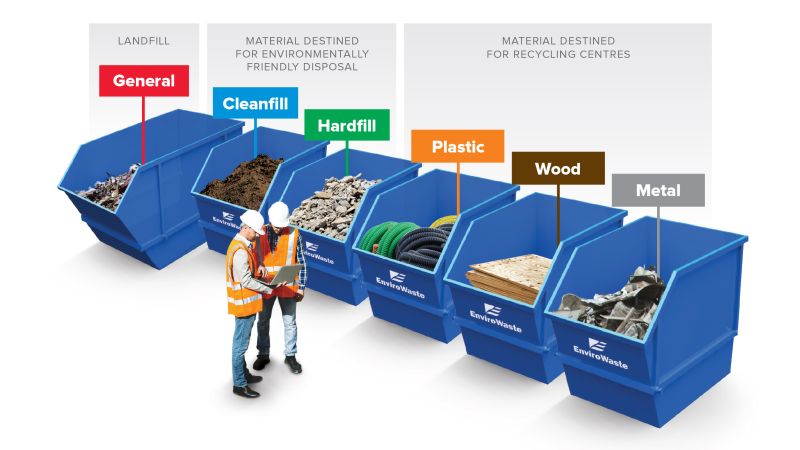
Sending waste to landfills or incineration should be the last option and only be used when all the other ‘R’ options have been ruled out. The government’s sustainable strategy is expected to aim to reduce the waste to landfill.
Changing old habits
Although various options exist for more sustainable waste management, eliminating the traditional over-ordering of materials will require a significant cultural shift, effective management support, and more concentrated planning efforts.
Strategies to minimise the volume of site excavation
To reduce the amount of earthworks (site excavation landfill waste your project will create), you can compare previous strategies used with modern sustainability methods for waste disposal in New Zealand to evaluate the best option for your project.
As we know now, landfill is the primary form of waste disposal in this country, but it is not a cost-effective practice due to the:
- high costs of operating and maintaining landfill sites
- limited availability of suitable land
- corrective action being expensive
- health hazards associated with reuse options for landfill sites
- high toxicity of emissions from landfill sites due to concentrations of heavy metals and toxic chemicals
- increasing tip fees.
As waste increases and associated costs rise, policymakers prioritise waste minimisation efforts.
By improving waste management practices on-site, we can not only reduce the environmental impact of waste but also avoid costly fines from waste levies.
Below is an example of three different materials and the strategies that can be used to minimise that volume of excavated waste.
| Materials | Outcome | Handling procedure |
|---|---|---|
| Excavated Soils | Reclaim on-site for backfill. Grade fill for future development. Bioremediation. Landfill. | Site Stockpile, ensuring wind/water erosion is prevented. |
| Asphalt | Reuse on-site as a temporary fill. Reuse elsewhere for road fill. Recycled. | Stockpiled, then crushed on- or off-site for fill. Stockpiled, then hauled to the recycling facility. |
| Concrete | Recycled. | Stockpiled, then crushed and removed. |
While construction and design waste (sometimes called C&D waste) is created by contractors on-site, the decisions made by designers significantly influence the type and amount of waste.
Further Reading
BRANZ offers valuable support in their article on Designing for waste minimisation.Safe and environmentally effective disposal of waste
Good practice is not the same as industry standard.
Industry standard refers to the:
WasteMINZgenerally accepted practices occurring within an industry at a given time, which may or may not reflect good practice.
Achieving good practice in health and safety requirements when dealing with waste products requires a planned and systematic approach. Changes in both process and behaviour are required to achieve health and safety excellence in an organisation.
Excellence in health and safety can be driven in two ways:
- Through systematic processes
- By developing a safety culture
Health and safety culture refers to a set of shared values and beliefs that guide behaviour and are influenced by an organisation's structures and control systems.
Unavoidable waste products can pose a risk to the safety of workers. Therefore, it is mandatory for builders to follow health and safety protocols and implement proper waste management procedures to ensure the safety of everyone on-site, including workers and visitors.
Every person on your build site must be responsible for ensuring the workplace is safe. The builder and subcontractors can remain compliant if they implement strategies to ensure safe and environmentally effective disposal of unavoidable waste.
ACC provides a step-by-step guide for supporting and carrying out workplace health and safety systems, as shown in the WorkSafe cycle.
Action
- Hazard management
- incident investigation
- training and supervision
- employee participation
- emergency readiness
- contractor management
- injury management
Subcontractor responsibilities
When finding subcontractors, you should ensure they have strategies for mitigating environmental impacts in their bid proposals. To follow through in their strategies, ensure that your terms of engagement incorporate clauses requiring waste minimisation practice. This includes requiring tradies to dispose of their waste and backcharging for segregating waste streams not segregated by each subcontractor. In turn, you should enlist your crew for general site clean-up regularly. Contracting these terms sets an example for your tradies and mitigates the potential for wind-blown litter and safety issues on-site.
When managing and minimising the waste from a building project, a commitment to reducing waste at the preliminary stage of construction is more likely to persist throughout the project.
In the development phase of the waste management strategy, the significance of calculating the costs, the potential savings, and the economic advantages of having a waste management strategy will be stipulated.
Additionally, the costs, potential savings, and economic advantages of a waste management strategy must be negotiated with clients. You may need to educate them that the initial costs of the waste management strategy are mitigated by the savings calculated at the end of the project, in terms of efficiency and overall environmental benefits. You may need to demonstrate that these advantages far outweigh the obstacles they may initially seem to create.
Cost savings analysis
The quickest analysis you can carry out is the cost-benefit analysis, which will determine if the strategy's benefits outweigh the costs.
Below is a procedure for conducting such an analysis.
| Step 1: Brainstorm costs and benefits | Make a list of all costs and benefits associated with the strategy. Study the waste strategy throughout its life cycle. Some costs may include equipment, transportation, and labour. Some benefits may include recovered resources, financial incentives, and potential savings. |
|---|---|
| Step 2: Assign monetary value to costs and benefits | Calculate the monetary value of each cost and benefit. Account for any related training, logistics, and overhead costs for each cost. Also, consider whether training would contribute to a decrease in productivity and make sure to account for that as well. |
| Step 3: Compare costs and benefits | Finally, it would be best if you determined whether the benefits outweigh the costs. Here is a simple equation to calculate the payback period, given that the same benefits are received each period. (Total Cost/Total Revenue (benefits) = length of time (payback period) |
One of the best ways to exemplify cost-saving measures to minimise adverse environmental impacts and promote sustainability is through the efficient and economical procurement of materials and products, which we will cover a bit later in the topic.
Realism

Development of the construction of a modern, modular house.
As we have covered, new, cost-effective building methods that encourage sustainability are being developed in the building and construction industry. Many new methods, such as prefabricated and modular constructions, reduce waste using the same materials and products for each build.
Therefore, materials are cut to standard sizes and styles with the same specifications regardless of the project. Modular construction, in particular, reduces cast-off waste and reduces waste due to its stacking methods and offsite builds.
Landfill is the traditional means of waste disposal in New Zealand, but this is uneconomic because the:
- costs to communities for operating and maintaining landfill sites are high
- availability of suitable land is limited
- reuse options for landfill sites are limited due to potential health hazards
- remedial action is expensive
- emissions and leachate from landfill sites can be highly toxic due to concentrations of heavy metals and toxic chemicals
- tipping (rubbish dumping) fees are increasing rapidly to reflect the actual cost of disposal.
In newer builds that use prefabricated methods and incorporate regulated material sizes and styles, the cost competitiveness of recycling options increases and waste minimisation efforts are rewarded.
The successful cost and waste reduction indicate clearly that waste management strategies that focus primarily on reducing waste are integral to sustainable building.
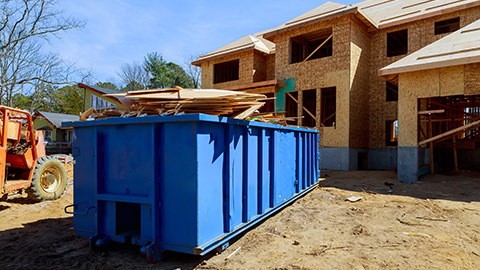
Recycling has been increasing recently due to the planet's overwhelming concerns. This concern is extended to the building and construction industry. Defining these industry-specific Rs, which are slightly different to the general meaning of the 3 Rs, helps you to figure out the best actions for your construction project.
- Recycle: Break down and create something else.
- Reclaim: No breaking down but used for a different purpose. e.g. a door becomes a tabletop.
- Reuse: No breaking down, and use for the same purpose.
When employing the 3 Rs with your materials, your project plans should incorporate these minimisation strategies concerning waste management. Consider looking to materials that have been recycled, reclaimed, or can be reused from demolition to save costs and increase sustainability efforts.
Example:
“Concrete obtained from a previous project demolition site is broken up into much smaller pieces, and these were all sifted to remove any impurities. The broken-up concrete is then used as a base for a footpath paving project”.
As you can see, sustainability was promoted by removing the need for new raw materials for the footpath paving project. Instead, we found a new way to use the old concrete from a previous demolition site. Therefore, when implementing the principles of the 3 R’s, remember to ask yourself if a better option can be made, what that option is, and how this can promote overall sustainability.
What's different?
The general three Rs (Reduce, Reuse, and Recycle) of waste minimisation can also be applied to any construction and demolition product to help relieve the environmental effects of landfills.
Here's how:
- Reduce: produce less waste. This is by far the most critical action any construction project could take.
- Reuse: reuse existing building materials wherever possible. Materials that can be reused after the useful life of the building will reduce the need for new materials to be produced in the future. How materials are installed and fixed can affect the ability to reuse them, so the shorter the expected life of the building, the greater should be the reliance on screw or bolt fixing rather than adhesive and other permanent fixings.
- Recycle: Recycling materials that have reached the end of their useful life wherever possible. Materials that can be recycled will reduce the need for new materials to be produced, and the energy required to reconstitute materials is generally much less than required for new production.
We'll start this section with a video introducing the complexity of biodiversity preservation in New Zealand.
Explore
Watch: New Zealand Biodiversity Strategy (2:04 minutes)
Construction and building projects have the potential to affect New Zealand's natural habitats and its established ecosystem.
The associated noise, pollution, and changes in land use all have the potential to be extremely damaging to our biodiversity. For example, local animal and plant species may be displaced or unable to survive as their native surroundings have changed.
During the planning stage, before any soil has been turned, you'll need to consider the appearance and function of existing buildings or structures that can be damaged as well as the natural aspects of the location.
Moving away from the building sites themselves, the intensive production and transportation of site resources themselves for our industry, as previously discussed, has the potential to affect the balance of the Aotearoa ecosystem.
Therefore, careful planning plays a critical role in protecting Aotearoa’s plants and animals, and the natural systems they live in, as well as the cultural heritage of previously built projects. Creating, and enhancing or at least conserving wildlife habitats and human communities should be high on your project priority list.
Assessment of Environmental Effects (AEE) accompanies each application for resource consent. This assessment involves the organised measurement of how projects will likely affect natural and man-made environments; this assessment aims to balance the need for development with environmental sustainability.
This assessment is typically required for projects that are likely to have significant effects on the environment under the Resource Management Act 1991 (RMA).
Further Reading
To obtain a more detailed understanding of this assessment, please refer to the relevant government publication.
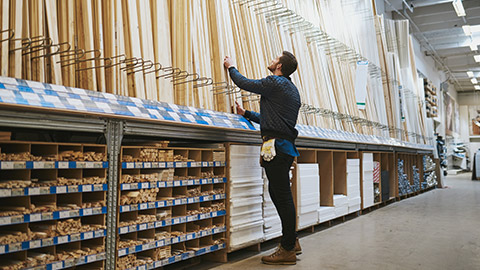
Buy with care
Traditionally, when selecting goods, services, and even buildings, the focus was primarily on price and quality. Yet, the decisions individuals and organisations make regarding their purchases can significantly influence sustainable development in various ways. It is becoming more and more crucial for both private organisations and public institutions to showcase their dedication to sustainable development by opting for more sustainable choices.
In New Zealand, construction workers and the companies they work for can refer to several guides and online resources related to sustainability procurement. These bodies can provide information on best practices for incorporating sustainable practices into your site projects.
Some of the commonly used groups include information from:
- New Zealand Green Building Council (NZGBC): The NZGBC provides a range of resources and guidance on green building practices, including sustainable procurement. They offer tools such as the Green Star rating system, which helps assess and certify the sustainability of buildings. The ‘Construction and Demolition Waste Guide’, produced by the New Zealand Green Building Council, provides extra information on reducing construction and demolition waste through sustainable procurement practices and waste management strategies.
- ISO 20400:2017: This national standard guides organisations, independent of their activity or size, on integrating sustainability within procurement, as described in ISO 26000. It is intended for stakeholders involved in, or impacted by, procurement decisions and processes.
- Building Research Association of New Zealand (BRANZ): BRANZ provides research, technical information, and guidance on sustainable building practices, including procurement. Their publications and resources offer insights into sustainable construction methods and materials.
- New Zealand Sustainable Business Network (SBN): The SBN offers resources and tools to help businesses, including construction companies, adopt sustainable practices. They guide sustainable procurement strategies and offer networking opportunities with other local sustainable businesses.
- MBIE (Ministry of Business, Innovation and Employment) and local government agencies: Their resources and individual guides are intended to help people involved in the procurement of building and construction projects understand how they can influence change in their practices to reduce carbon emissions.
These are just a few examples of resource providers that produce guides and advice to help you and your workers incorporate and understand sustainability procurement practices, leading to more environmentally friendly building projects.
Know your supplier
"What are your sustainability promises?" Challenging supply chain partners on sustainability can benefit your practices by:
- reducing environmental impact
- enhancing reputation
- mitigating risks
- driving innovation
- increasing competitiveness
- achieving cost savings.
As a commercial consumer of goods and services and a supplier, you should be encouraging sustainable practices throughout the supply chain to create a more sustainable and resilient project model.
Your material or resource supply partners should be asked to demonstrate:
- evidence of environmental, social and economic policies in place and used on previous projects
- a commitment to engage with local communities and evidence of this in previous projects
- proactivity in enabling clients to upskill their competence
- sustainability and community engagement plans are in place and active
- previous experience with Green Star/Homestar projects.
Managing procurement solutions to minimise waste
Use Recycled Materials
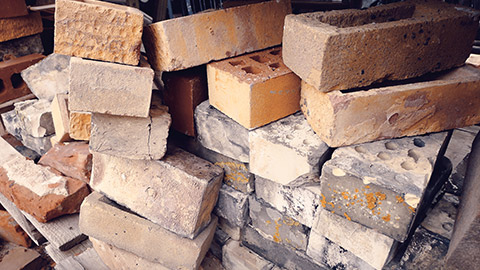
Bricks can be salvaged from demolition, cleaned up, and used for construction projects.
Consider using recycled materials, where appropriate, that meet regulatory and standards' restrictions. Recycling, reclaiming, and reusing materials can drastically impact the waste management strategy and are of utmost importance to remain economical, efficient, and compliant.
Life cycle
As we have indicated, an effective waste management strategy will incorporate assessing the materials and products used in the project-building process.
We have previously mentioned how the cost of materials can affect a project's economic and environmental impact. So when evaluating building materials, we need to identify high-quality and more durable materials to meet the environmental needs; this is because we want to select those materials that will extend the life span of the built structure.
The choice of materials could simplify future extensions and refurbishments.
The procurement choice to integrate specific products and materials over lower-performing counterparts must be considered within the life cycle of each item and then integrated into the waste management plan. A Life Cycle Assessment (LCA) is a technique for assessing the potential environmental aspects and potential aspects associated with a certain product.
The assessment of the whole life cycle of materials and or products follows these events:
- The raw material resource extraction
- Manufacturing
- Delivery and transportation
- Use, maintenance, and repair
- Disposal or recycling
The table below is an example of an LCA in a scenario where timber will be used in the project. Note that each assessment might vary depending on the construction method, materials used, and client's specifications.
| The Aspect of Life Cycle Assessment | Potential Negative Impacts |
|---|---|
| Raw material resource extraction | The potential negative environmental impact of raw material's extraction is very low. The timber that will be used to create mud will be from the clearing for the house’s site, and they will use any from a different location. This will also minimise the waste generated during construction because they found a way to use the cleared timber instead of merely disposing of it in a landfill. |
| Manufacturing | The potential negative environmental impact of the manufacturing process is high. The supplier’s production plant is located at another site, and termite treatment of the timber can create pollutants from chemical formulas. |
| Delivery and transportation | The potential negative environmental impact of the manufacturing process is very high. The supplier’s production plant is located at another site, so transportation will create pollutants to be released and expensive for bulky transport. |
| Use, maintenance, and repair | The negative impact of using timber from the construction site is relatively low in terms of use and maintenance. Although transport, manufacturing, and treatment can produce a relatively higher environmental impact, timber is considered a sustainable material preference. It will likely require very little maintenance over the lifecycle. |
| Disposal or recycling | The potential negative environmental impact of timber at the end of its life is also very low. Recycling timber is typically very easy, and the materials can be used to create new building materials. This reduces the amount of waste disposed of in a landfill. |
Managing resource demand and usage
When selecting and integrating products and materials, prioritise high-quality options over lower-performing alternatives. Consider their LCA and ensure they are incorporated into the waste management plan. Ultimately, reducing the frequency of replacements benefits everyone involved.
Further to this, remember to manage resource demand and consumption to ensure accurate ordering. Evaluating building materials over the life cycle will identify better quality and more durable materials that will extend the structure's life.
Importantly, don't:
- order less efficient products
- overorder products
- obtain more products than you need.
When considering the resource demand and usage, ensure that your building materials are durable and high-quality, which will strengthen your built product's sustainability and minimise waste across its life cycle.
What would you do?
We've covered many factors that need to be considered when managing resources. Use that learning to list the characteristics of the various products and materials for a residential build. Think about pollutants, fabrication methods, locations, and their environmental impacts.
When you are done, take a look at our list by expanding the label below, taking note of anything you hadn't included on your list.
- Life Cycle certified by an accredited scheme. e.g. Eco Choice Aotearoa
- Renewable over non-renewable or finite resources
- Low in embodied energy
- Certified as non-threatening to biodiversity
- Low toxicity in both production and operation
- High in renewable, recycled or reclaimed content provided durability and performance are appropriate for life span.
To help minimise the negative environmental impact you could:
- Examine successfully sustainable past projects to see how many and which resources were used.
- Make sure that the project only uses the allocated resources.
By examining similar past projects, you can develop a somewhat accurate estimate of how much of a particular resource is needed for future projects. This research will enable you to prepare for the procurement process. If you can order what you need when you need it, you avoid material degradation and the need to replace resources, which lessens the stress placed on the environment. By coordinating procurement efforts, these actions will result in fewer deliveries, thereby reducing air pollution.
Furthermore, by ensuring that the project only uses the budgeted resources, you avoid overage and waste, meaning fewer raw materials will have to be disposed of.
Minimise packaging waste
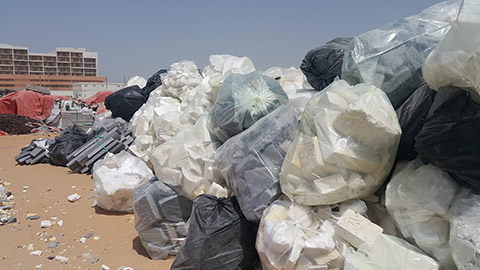
These bags are filled with construction polystyrene foam waste and cut pieces awaiting removal for either disposal or recycling.
Procurement specification
The bottom line is that organised and careful purchasing of materials and products can decrease the overall costs of the project, providing a convenient alignment between saving money and saving the environment.
Below are some examples of procurement types and how they can promote sustainable building practices.
| Procurement method | Outcome | Example of Method Promoting Sustainability |
|---|---|---|
| Effective procurement | The goals of the procurement method are met. | Wherever possible, choose materials that can be recycled rather than must be disposed of in a landfill. |
| Efficient procurement | Unnecessary expense is avoided. | Keep a current and organised inventory of materials so you can ensure you are using up what you have before procuring additional resources. Don't waste money on resources that may need to be disposed of, causing even more expense. |
| Economical procurement | Increased sustainability practices across the industry. | Opting to invest more in materials sourced from environmentally friendly and ethical suppliers reflects a commitment to balancing financial considerations with environmental values. Supporting organisations that align with your own values is not only good practice but also promotes an industry that champions sustainable practices. |
It is important to enforce procurement specifications for packaging waste reduction to align with your waste management plan.
There are many reasons why packaging waste should be reduced, the most common benefits are that:
- energy consumption will be reduced when taking in raw materials instead of processed or manufactured into packaging
- air pollution, a result of on-site packaging waste not disposed of appropriately, will be reduced as the pollutants that are released into the air, such as dust and carcinogenic substances, are reduced
- reduced risk of having hazardous components in landfills due to packaging and degradation of plastic within the landfill site.
In general, the considerations you need to make to minimise packaging waste include:
- packaging and packaging waste types found on construction sites
- measures to eliminate, reduce, re-use and recycle packaging waste that are practical and economical
- how to conduct waste segregation
- issues encountered by management regarding minimising packaging waste
- tools, information, advice and resources to help improve packaging waste management at the construction site.
In summary, locating, and using suppliers who are part of the sustainability business network or framework would provide optimum results due to shared objectives of reducing packaged waste linked to sustainability.

This timber was taken from a demolition project and is waiting to be cleaned up and reused in a new build or sold to suppliers.
Working in construction, demolition, and recovery of materials can drastically impact the waste management strategy you use.
Demolition generates significant wasted materials such as concrete, asphalt, and metals. Part of your responsibility is adopting demolition practices that increase the recovery of materials for recycling and reuse.
Below are some basic demolition practices that could be used depending on the type of material:
| Concrete and bricks | Use crushed concrete and brick in low-grade roads and pavement sub-bases. |
|---|---|
| Asphalt | Reclaimed or recycled asphalt may be mixed in with new asphalt. Coordinate with asphalt suppliers for more information. |
| Metals | Coordinate with steel manufacturers to sell steel debris. |
| Timber | Recover and salvage high-value timbers during demolition and sell them to suppliers. |
| Plasterboard | Coordinate with plasterboard manufacturers to recover and sell plasterboards from construction sites. |
| Rock and excavation stone | Coordinate with aggregate manufacturers to sell excavated rock and stone. |
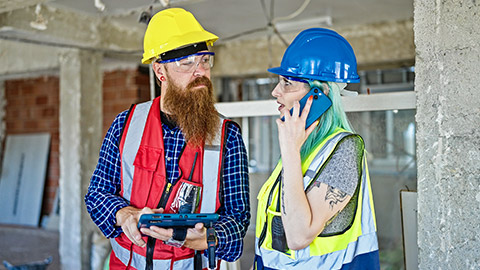
All worksites must have established effective communication strategies to ensure project waste minimisation practices are effective. The execution of successful waste management procedures on a building project is most effective when there is open, frequent, and transparent communication between all personnel and stakeholders involved.
In addition to having a successful waste management procedure, all parties must be well-informed to allow for collaboration, which ensures the project's waste minimisation is supported. In other words, if you have a waste management procedure but nobody knows it, do you really have a waste management procedure?
A site supervisor is primarily responsible for communicating procedures related to the company's waste management strategy.
Effective supervisors inform and instruct all relevant personnel of the planned waste management procedures. They will also incorporate organisational software, like spreadsheets and schedules indicating project task stage deadlines, to ensure waste and procurement are managed at the appropriate time.
The grease to make this all work is effective communication, which leads to effective collaboration.
As you may expect, in addition to in-person conversations on-site or elsewhere during the planning phase, these forms of collaboration will require digital devices such as laptops, mobile phones, and tablets.
After identifying the project's requirements and outlining the quality control processes needed, it is essential to disseminate information effectively.
Communication planning involves:
- Identifying what information you need to convey
- Determining where you source the information.
- Identifying who and how you want to relay this information.
- Research the available means of communication to make information more accessible.
- Keep the information simple and easy to understand.
Now that you have learned how important it is to communicate on the project, let's refresh some of the other things we have learned in this module with this four-question quiz:
Measuring progress towards sustainability goals
As you've likely noticed, there is a growing interest in environmental issues around the world, and energy costs are rising. As a result, builders and occupants are becoming more concerned about their buildings' long-term costs and value.
To stay competitive in New Zealand, building companies and their workforce are increasingly required to demonstrate their environmental practices or records by providing reliable performance information. To do this, they must be able to provide measurements of the impact of their sustainability practices.
There are digital tools available to measure and evaluate progress and methodologies that can help determine your project's sustainability planning. They will take some consideration to align the tool with your particular project's desired outcomes.
A growing number of governmental initiatives and third-party ratings mean that the construction industry must plan to address a broad range of sustainability issues, including environmental, economic, and social factors that will be unique to each project. Does that sound familiar? It should, it's the 3 Ps of sustainability.
Monitoring the success of sustainability goals
Your project success can be monitored during the design and post-construction stages. Sustainable success is determined by specific attributes, including:
- energy use
- water use
- biodiversity protection and enhancement
- materials use
- waste and recycling
- Indoor Environment Quality (IEQ)
- emissions.
Note: A Green Star/Homestar rating certification will address and consider these attributes or qualities. The rating will also strengthen decision-making and showcase value to the public.
Benchmarking
Benchmarking is used in measuring sustainability. It's a process that companies use to evaluate various aspects of their processes and practices to advance overall performance.
By comparing your sustainability practices, resource use, and waste management to industry benchmarks or best practices, you can identify areas for improvement and set realistic sustainability goals. Benchmarking can also help you track your progress over time and demonstrate your commitment to sustainability to stakeholders and clients.
Key Performance Indicators (KPIs)
Key Performance Indicators (KPIs) specific to a project's environmental goals are an excellent way to measure sustainability on a construction site because they provide quantifiable metrics that can track progress and performance over time. The information provided by an organisation’s KPIs can be used to monitor and improve performance throughout the project's stages. Overall, having site KPIs provides a structured and effective way to measure, monitor, and improve sustainability performance on your site.
A summary of carbon reduction
Explore
Watch: Reducing Carbon: Where is it in a building? (4:46 minutes)
We've provided this excellent video by BRANZ to ensure you've picked up the essential ideas about reducing carbon in our buildings.
Activities
Have a bit of fun finishing off this topic with activities designed to consolidate your learning and gain confidence in your knowledge of what it takes to be a sustainably smart supervisor on a residential construction build.
Writing
Put on your supervisor or project manager hat to complete this writing activity.
Quiz time
Move on to this four-question quiz. Use the navigation below the question to progress.
Document your sustainability goals
Create a promise and a study guide with this documentation tool activity.
Case Study Quiz
Read the following Case Study and then answer questions about the situation.
Case Study
Sustainable Residential Building
Read the following passage on a residential building project in New Zealand that exemplifies good sustainable pillars of construction practices.
The project involves the construction of a multi-unit residential building in Auckland, with a main focus on sustainability in its design, construction, and operation.
The building's goal was designed to be cost-effective, focusing on optimising the use of materials and reducing their collective construction waste. In the design stage of the project, there was a focus on energy-efficient features, such as high-performance insulation, LED lighting, and efficient heating and cooling systems, garden landscapes all incorporated to help reduce long-term energy costs for the residents.
Careful consideration was taken on using the ‘life cycle costing’ to evaluate the economic impact of design decisions over the building's lifespan, ensuring that the sustainable features installed would provide long-term cost savings. The project's leaders, at certain stages, engaged with the local community throughout the design and construction process — soliciting feedback and incorporating community needs and preferences into the building's design.
This building was designed to be accessible to people of all ages and abilities, with features such as step-free access, wider doorways, and accessible parking spaces. Considerations were taken in the building's design to promote a healthy indoor environment, with natural ventilation, and low-toxicity materials, while encompassing Auckland’s ample natural light.
When it came to site practices, the project manager used environmentally friendly building materials, such as sustainably sourced timber from BBS Timber, which is affiliated with the Programme for the Endorsement of Forest Certification (PEFC™), recycled content materials from previous projects, and the team kept deliveries to a minimum using only vehicles on -site that produced low-emissions. In addition to the design being energy-efficient, a renewable energy source of six solar panels on the north-facing side of the roof was incorporated to reduce the building's reliance on fossil fuels.
The team held regular meetings with the supervisor to discuss ways to reduce water wastage and promote sustainability. The team focused on the three R's: Reduce, Reuse, and Recycle. To reduce the residents' water consumption, low-flow toilets and faucets were installed, which were linked to the WELS Rating Star system.
Lastly, the company is renowned for having a comprehensive waste management plan embedded in their company's procedures which was implemented during construction to minimise waste sent to landfills, with materials recycled or reused wherever possible.
Outcome: This completed Auckland residential building not only provides comfortable and affordable housing for its residents but has also received A 6-star Homestar rating.
Answer the following eight questions about the project.
Well done. That was a good amount of reflection!
That's the end of module 11. Let's hear a summary of what we've covered so far.
Click ‘Video Transcript’ or the plus icon (+) to expand and reveal the transcript for the previous video.
Thanks for hanging out with us as we explored sustainable construction practices! It's exciting to see how we can make a positive impact on our planet and communities through our work. Let's keep the momentum going and continue to build with sustainability in mind. Together, we can build a brighter, greener future. Take care and happy building!
